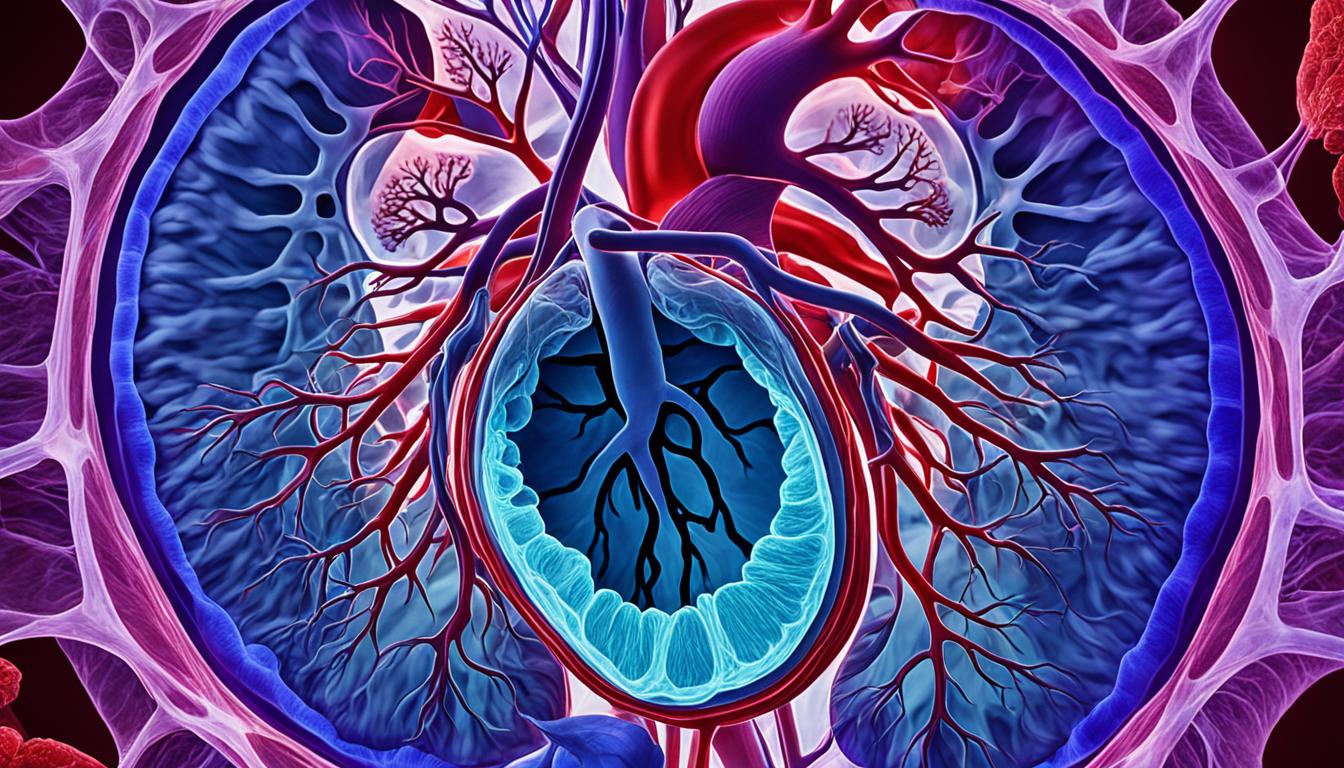When the leaflets of the mitral valve get damaged and bulge, it is called prolapse mitral valve. This happens as the heart contracts. In this condition, blood can leak back into the left atrium, known as mitral regurgitation. Although it’s not usually life-threatening, mitral valve prolapse could cause shortness of breath, chest pain, or tiredness. It’s vital to catch it early and start treatment. Doctors use tests like echocardiography, X-rays, and ECG to diagnose it. For some, just medication, like beta blockers or aspirin, is enough. But, severe cases might need surgery. Repairing or replacing the valve are the options. Lately, stem cell therapy has emerged as a promising new way to repair the heart and help it work better.
Key Takeaways:
- Prolapse mitral valve results when the valve leaflets are damaged and bulging into the left atrium.
- This can cause blood to leak back, known as mitral regurgitation.
- Typical signs are short breath, chest pain, and fatigue.
- Tools like echocardiography, X-rays, and ECG are used for diagnosis.
- Treatment varies from medication to surgery, depending on the issue’s seriousness.
- Beta blockers and aspirin are common medicines doctors prescribe.
- If surgery is needed, it might be a repair or a replacement of the valve.
- Stem cell therapy offers hope in fixing heart tissue damage.
What is Mitral Valve Prolapse?
Mitral Valve Prolapse happens when the mitral valve’s leaflets in the heart get damaged. They bulge into the left atrium during heart contractions. This issue can cause blood to leak back into the atrium, not into the ventricle as it should.
Despite not being usually life-threatening, mitral valve prolapse can show symptoms like chest pain or fatigue. It’s crucial to catch it early and treat it to avoid complications.
People with this condition might feel heart palpitations, dizziness, or anxiety. These symptoms might change in how strong they are and how often they appear.
Doctors might use different names for this condition, like floppy valve syndrome. But, they all mean the same thing.
If you think you have mitral valve prolapse, see a doctor. They can figure out what’s going on and help you find the right treatment.
The Impact of Mitral Valve Prolapse
Mitral valve prolapse affects everyone differently. For some, it’s not a problem. But for others, the symptoms can really affect their lives.
Common signs of this condition are shortness of breath and chest pain. Feeling tired, having heart palpitations, and being dizzy are also possible. So is feeling anxious.
How bad and how often these symptoms appear can differ from person to person. It’s very important to talk to a doctor. They can help you manage the symptoms and look after your heart.
Diagnosing Mitral Valve Prolapse
Doctors start diagnosing mitral valve prolapse with a detailed check-up and your medical history. They listen to your heart with a stethoscope. They can hear sounds that tell them something may be wrong.
After the check-up, you might have tests like an echocardiogram. This test uses sound waves to make pictures of your heart. It lets doctors see how the mitral valve is working.
- X-rays see your heart’s size and shape. This helps rule out other problems.
- An ECG checks your heart’s electrical signals to spot any issues.
- Exercise tests monitor your heart while you’re active. They can show how bad your prolapse is and check for symptoms.
- Cardiac catheterization is rarely needed to look closely at your heart’s blood flow and pressure.
All these tests help doctors figure out if you have mitral valve prolapse. They’ll also help decide how severe it is and the best way to treat it.
Diagnosing Mitral Valve Prolapse
Mitral valve prolapse happens when a part of the valve bulges into the left atrium. Doctors diagnose it in a few ways. These tests help figure out how severe it is and what treatment to use.
Echocardiography
Echocardiography is a way to look at the heart using sound waves. It helps show the mitral valve and how bad the leaking is. This gives doctors key info about the prolapse’s state and how it’s changing.
X-rays and Electrocardiogram (ECG)
Doctors also use X-rays and ECGs to check for mitral valve prolapse. X-rays take pictures of the heart’s shape and size, which echo results. ECGs look at the heart’s electrical signals, spotting issues that might help diagnose the condition.
Exercise Testing
Sometimes, the heart is tested during exercise to see how well it works. This could involve walking on a treadmill or biking. This test checks how the heart responds to stress and finds any issues not seen at rest.
Cardiac Catheterization
Cardiac catheterization is a detailed heart test. A thin tube is put into a blood vessel, letting doctors see the heart closely. It shows exactly what’s happening with the mitral valve, helping make treatment choices.
With these tests like echocardiography, X-rays, ECGs, exercise testing, and cardiac catheterization, doctors can diagnose mitral valve prolapse accurately. This helps them pick the best way to treat it.
Treatment Options for Mitral Valve Prolapse
The treatment you get for mitral valve prolapse depends on how bad it is and if you have symptoms. If you don’t have symptoms, you might not need any treatment. But, if you do, your doctor could give you medicine.
Beta blockers are a type of medicine. They can make your heart beat slower and lower your blood pressure. You might also take aspirin to stop blood clots.
If your condition is really bad, you might need surgery. The best option is mitral valve repair. This means the surgeon keeps your own valve if they can fix it. Otherwise, they might replace it with a new valve.
There’s also an exciting treatment using stem cells. This treatment tries to fix your heart’s damaged parts and make it work better. It can provide a long-lasting fix for mitral valve prolapse.

